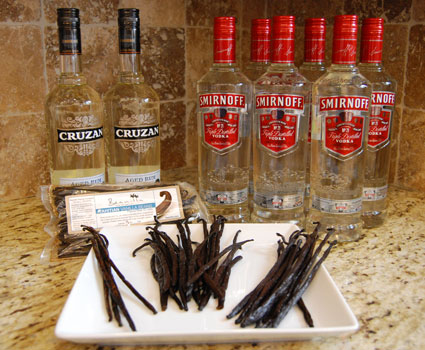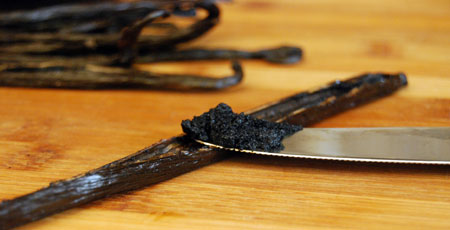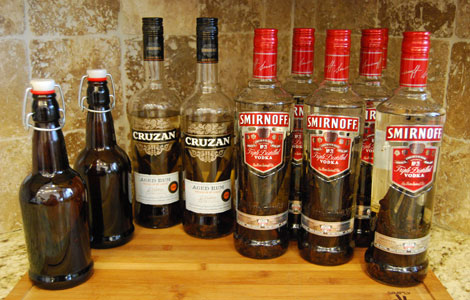How to Make Vanilla Extract


Making homemade vanilla extract is something anyone can do. Whether you're making it to bottle
for friends as gifts, or whether you like to save money or whether you're a whiz in
the kitchen that knows the best ingredients help make the best meals then this
is just what you're looking for.
What Vanilla Beans to Use
To make your own vanilla you should start with a good quality vanilla bean.
If this is your first time making vanilla I would suggest the Madagascar vanilla beans (shown right).
It's the most common variety which accounts for over 60% of vanilla beans on the market and the one used in
most store-bought vanilla extracts.
Vanilla beans are usually hand-pollinated and hand-harvested. This extra care is what
adds to the cost of producing the pure vanilla extract you've always purchased. One thing
you'll want to know (to save you money) is that you want to purchase extract grade
vanilla beans. These are a hundred times cheaper than the A-grade/Premium beans that cost about
$6 each in most grocery stores.
Aren't A-grade vanilla beans better? No, not in this case. With B or extract-grade beans
they contain 10-15% less moisture so they have less water weight. This means you'll be
paying less for them and you won't need as many to get the same strength in flavor.
A 1/2 lb package is more than enough for 4 - 750ml bottles. Have a friend make some with you and split the costs!
is more than enough for 4 - 750ml bottles. Have a friend make some with you and split the costs!
Where to get Vanilla Beans
There are several great importers that sell vanilla beans through Amazon.
This is where I get mine. My favorites sellers are
Vanilla Products USA ,
Beanilla ,
Beanilla and
Arizona Vanilla and
Arizona Vanilla .
And if you choose the "super saver shipping" you can get them shipped for free.
On the right side of the page, just above the "Ingredients" section, there are links that show the current prices for
1/4 lb .
And if you choose the "super saver shipping" you can get them shipped for free.
On the right side of the page, just above the "Ingredients" section, there are links that show the current prices for
1/4 lb ,
1/2 lb ,
1/2 lb and
1 lb packages and
1 lb packages of Extract-Grade Madagascar or "Bourbon" Island vanilla beans.
of Extract-Grade Madagascar or "Bourbon" Island vanilla beans.
The Madagascar vanilla beans are going to be the best deal per pound over all the
other varieties. This is for 2 reasons: they are plentiful and it's easier to get
them in Extract-Grade. They have a great rich flavor and are always available.
Vanilla beans are grown all around the world and the subtle difference of soils or climates
play a role in the minor differences in flavor found in each one.
If you want to know more about the other varieties I've included links and information for them on the vanilla beans page.
Here are quick links to each one listed on that page:
Madagascar/Bourbon Vanilla Beans
Mexican Vanilla Beans
Tahitian Vanilla Beans
India Vanilla Beans
Indonesia ("Java") Vanilla Beans
Tonga Vanilla Beans
Which Alcohol to Use
Any 35-40% alcohol can be used for extracting, but a decent quality vodka will be the most
neutral flavor. This range is best suited for making extracts and won't overpower the flavor.
Some bottles may list a "proof" number, this is just double the percentage of alcohol
(i.e., 40% alcohol is 80-proof).
Why alcohol? All vanilla extracts have alcohol in them. Store-bought vanilla is actually required by the FDA to include a
minimum of 35% alcohol and a specific weight of beans per gallon to be labeled "pure". Even McCormick's vanilla extract uses 70 proof alcohol
(among many other ingredients). Lastly, imitation vanilla is made by soaking alcohol into wood which contains vanillin (the flavor element of vanilla).
So don't worry about using alcohol.
If you want to experiment you can try rum, gin, brandy or any other alcohol you want. Keep in mind that it will
contribute to the overall flavor of the vanilla extract. Also, know that 1 liter of vanilla may
last some people years (not me...) and like most fine wines the vanilla actually gets better with age.
So you may be tempted to save a few dollars on a cheap brand or go overboard and spend more than you need to,
but don't. I've known a few that have experimented with a variety of cheap and quality vodkas with a noticeable difference.
However, most quality vodkas were indistinguishable in flavor from each other. So use what you like, but start with a good alcohol!
In the above picture I used Smirnoff Triple-Distilled vodka and Cruzan Aged Rum from the Virgin Islands.
These are good quality liquors that aren't too expensive. For a unique flavor I also used a Bacardi Gold spiced rum.
Use what you like as long as it's 35-40% alcohol. Higher proofs won't work quite as well.
I've heard some visitors have done comparisons with several cheap and quality vodkas. In
their experience, the different brands of cheap vodka were nearly indistinguishable from
each other. The same was true between the quality brands of vodka.
They could however tell a difference between those quality brands and the cheap stuff.
|
Useful Equipment

What do you need to make vanilla extract? You just need vanilla beans, alcohol, a knife and a cutting board. That's it. It's that simple.
However, if you're thinking about doing large quantities I would plan to get some
dark colored re-sealable bottles and a funnel so you don't have to waste any alcohol. I use a
funnel with a strainer
and a funnel so you don't have to waste any alcohol. I use a
funnel with a strainer so that I can also use it strain out the vanilla when transferring to smaller bottles.
so that I can also use it strain out the vanilla when transferring to smaller bottles.



Getting Started

Making homemade vanilla extract is easy and cost effective. Select the variety of vanilla bean
you want. The classic bean used is the Madagascar vanilla bean (below). A 1/4 lb package should contain about 25-27 beans.
Ingredients
1 - 750ml bottle of 75-80 proof vodka (80 proof = 40% alcohol)
12 extract grade vanilla beans
Prep Time: 10 minutes / Aging Vanilla: 3-6 months
The preferred method to do this is by removing about 1/2 cup of liquid from each bottle. For a reference
point I normally empty the bottle down to the top edge of the bottle's label so there's room to shake the liquid.
You can pour this alcohol into another re-sealable container. Then using a paring knife, or even a butter knife, cut each bean length-wise.
It's easiest if you press just hard enough to cut only one side of the bean. Next, I like to separate the seeds from the bean
as it tends to mix better. To do this, just use the back-side of the knife to slide down the bean and scrape them out.
Then wipe the knife off into the bottle. You can also just skip this step and only cut the beans open (your choice).

Now cut the vanilla beans in half or smaller - short enough to keep them completely immersed. Do this for all 12 vanilla beans.
Put the vanilla beans in the bottle, wipe the top clean and replace the cap. The entire process takes about 10 minutes
per bottle. Store it in a cool, dark place for the next few months. Shake it every week for the first 4-6 weeks and then
whenever you get a chance thereafter. Make sure you get the lids back on tight if you open it - it's hard to resist smelling it.

That's it. 1. Cut 2. Scrape 3. Bottle it 4. Shake and wait
Aging the Vanilla
 After 2-3 months it should look like this and you can actually sample it, but it takes 6 months for the full flavor to be extracted.
You can leave the beans in for a few more months or up to about a year. The beans won't last indefinitely though.
They'll dry as you start using the vanilla and they become exposed.
After 2-3 months it should look like this and you can actually sample it, but it takes 6 months for the full flavor to be extracted.
You can leave the beans in for a few more months or up to about a year. The beans won't last indefinitely though.
They'll dry as you start using the vanilla and they become exposed.
So after 6 months, or when ready, filter your extract.
Use a cheesecloth or a fine strainer to remove the pods and any undissolved bits from the extract. Note: dry out the beans and save
them to make vanilla sugar.
Now that you've made the best vanilla extract ever - go out and do some baking, bottle it for Christmas gifts
or you could even start selling it at farmers markets. ENJOY!!
|